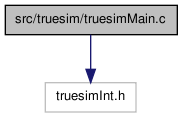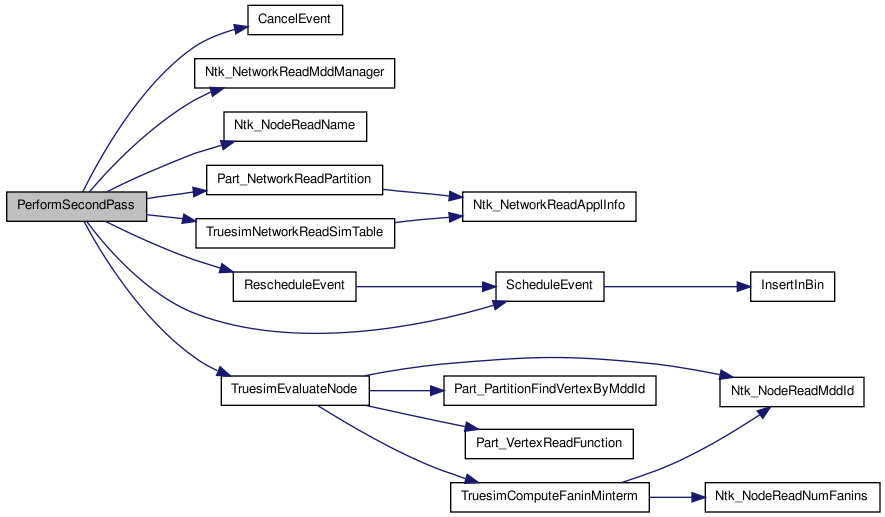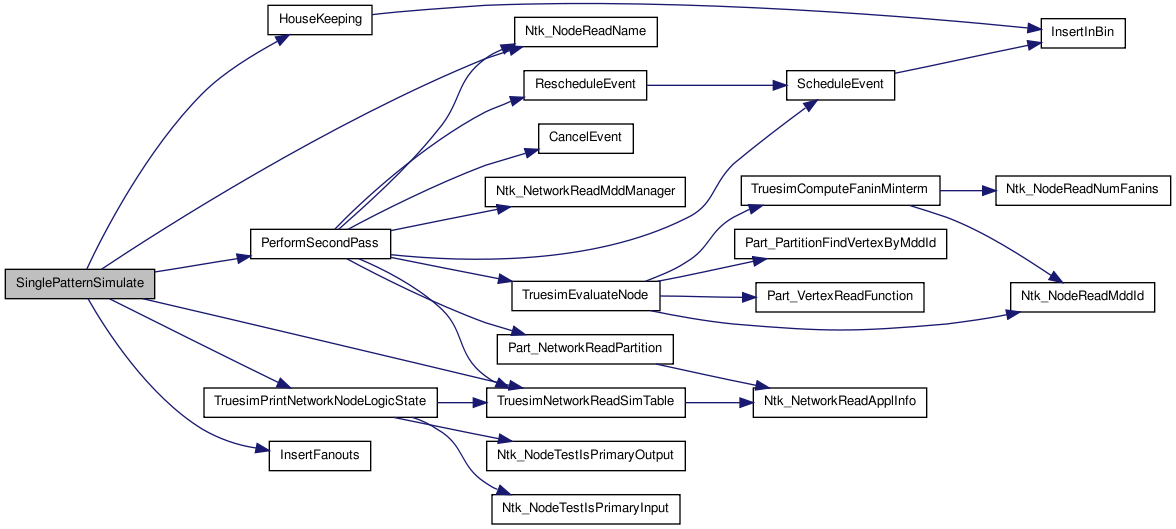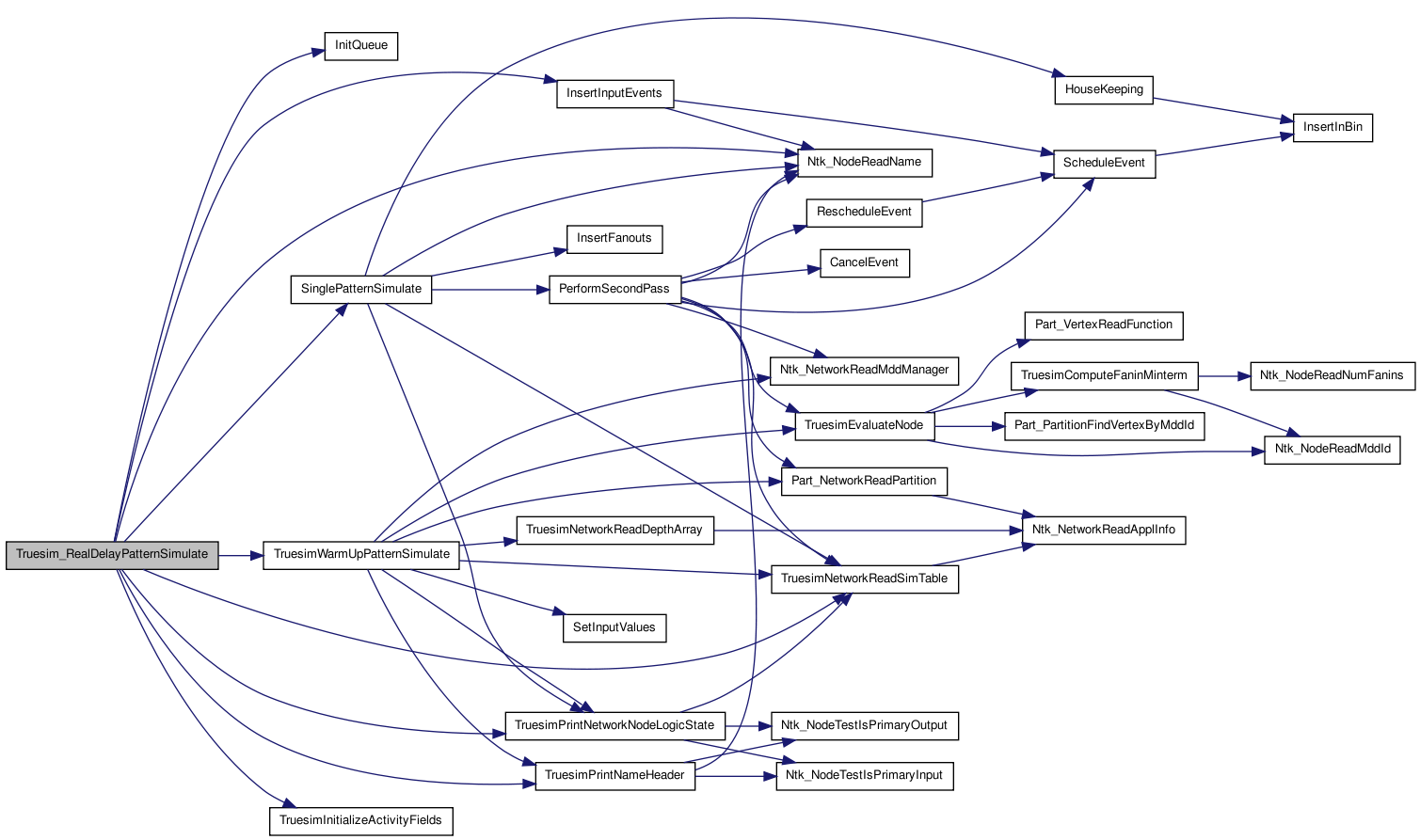#include "truesimInt.h" Include dependency graph for truesimMain.c:
Include dependency graph for truesimMain.c:Go to the source code of this file.
Functions | |
| static void | InsertInputEvents (st_table *nodeToSimTable, EventQueue *queue, array_t *inputArray, char *vector) |
| static void | SinglePatternSimulate (Ntk_Network_t *network, EventQueue *queue) |
| static void | HouseKeeping (EventQueue *queue, Event *threshevent) |
| static void | InsertFanouts (Ntk_Node_t *node, st_table *fanoutTable) |
| static void | PerformSecondPass (Ntk_Network_t *network, EventQueue *queue, st_table *fanoutTable) |
| static void | ScheduleEvent (EventQueue *queue, Ntk_Node_t *node, TrueSim_t *sim, char value) |
| static void | RescheduleEvent (EventQueue *queue, Ntk_Node_t *node, TrueSim_t *sim, char value) |
| static void | CancelEvent (EventQueue *queue, TrueSim_t *sim) |
| static void | InsertInBin (Event **wheel, Event *event) |
| static EventQueue * | InitQueue (void) |
| static void | NewPage (EventQueue *queue) |
| static enum st_retval | stTrueSimFree (char *key, char *value, char *arg) |
| int | Truesim_RealDelayPatternSimulate (Ntk_Network_t *network, array_t *inputArray, array_t *patternArray) |
| void | Truesim_InitializeSimulation (Ntk_Network_t *network, char *delayFile, boolean truedelay, int header, int verbose, st_table *nodeDelayTable) |
| void | Truesim_QuitSimulation (Ntk_Network_t *network) |
| void | TruesimEndSimulation (void *data) |
Variables | |
| static long | numEvents |
| int | truesimVerbose |
| int | truesimRptHeader |
Function Documentation
| static void CancelEvent | ( | EventQueue * | queue, |
| TrueSim_t * | sim | ||
| ) | [static] |
Function********************************************************************
Synopsis [Cancel an event.]
SideEffects [None]
SeeAlso []
Definition at line 700 of file truesimMain.c.
{
Event *event;
event = sim->event;
TYPE(event) = SIM_EVENT_C;
sim->event = NIL(Event);
} /* End of CancelEvent */
 Here is the caller graph for this function:
Here is the caller graph for this function:| static void HouseKeeping | ( | EventQueue * | queue, |
| Event * | threshevent | ||
| ) | [static] |
Function********************************************************************
Synopsis [This function is called when control events (th1,th2 and th3) are encountered. The time frame represented in the queue is increased by half and the time stamps on the control events are updated to reflect the same. Events earlier beyond th1 are bow brought into the wheel.]
SideEffects [None]
SeeAlso []
Definition at line 518 of file truesimMain.c.
{
Event **wheel;
Event *event, *threshold1;
Event *temp;
long threshold1_time;
wheel = queue->wheel;
/* add T/2 to all threshold events */
threshold1 = queue->th1;
TIME(threshold1) += HALF_PERIOD;
TIME(queue->th2) += HALF_PERIOD;
TIME(queue->th3) += HALF_PERIOD;
threshold1_time = TIME(threshold1);
event = NEXT_HOR(threshold1);
while(TIME(event) <= threshold1_time) {
NEXT_HOR(threshold1) = NEXT_HOR(event);
temp = event;
while (NEXT_BOT(temp) != temp) {
InsertInBin(wheel,temp);
temp = NEXT_VER(temp);
}
InsertInBin(wheel,temp);
event = NEXT_HOR(threshold1);
}
} /* End of HouseKeeping */
 Here is the call graph for this function:
Here is the call graph for this function: Here is the caller graph for this function:
Here is the caller graph for this function:| static EventQueue * InitQueue | ( | void | ) | [static] |
Function********************************************************************
Synopsis [Initialize the queue.]
SideEffects [None]
SeeAlso []
Definition at line 790 of file truesimMain.c.
{
EventQueue *queue;
Event **wheel,*threshold;
int i;
queue = ALLOC(EventQueue, 1);
queue->wheel = ALLOC(Event *, WHEEL_SIZE);
queue->current = NIL(Event);
queue->time = 0;
queue->freeList = NIL(Event *);
queue->nextFree = NIL(Event);;
/* Allocate control events, th1, th2 and th3 and thi (infinity)*/
EVENT_ALLOC(queue, threshold);
queue->thi = threshold;
TYPE(threshold) = THRESHOLD_I;
TIME(threshold) = MAX_TIME;
NEXT_HOR(threshold) = NIL(Event);
NEXT_VER(threshold) = NIL(Event);
NEXT_BOT(threshold) = threshold;
EVENT_ALLOC(queue, threshold);
queue->th1 = threshold;
TYPE(threshold) = THRESHOLD_1;
TIME(threshold) = PERIOD -1;
NEXT_HOR(threshold) = queue->thi;
NEXT_VER(threshold) = queue->thi;
NEXT_BOT(threshold) = threshold;
EVENT_ALLOC(queue, threshold);
queue->th2 = threshold;
TYPE(threshold) = THRESHOLD_2;
TIME(threshold) = PERIOD -1;
NEXT_HOR(threshold) = queue->th1;
NEXT_VER(threshold) = queue->th1;
NEXT_BOT(threshold) = threshold;
EVENT_ALLOC(queue, threshold);
queue->th3 = threshold;
TYPE(threshold) = THRESHOLD_3;
TIME(threshold) = PERIOD-1;
NEXT_HOR(threshold) = queue->th1;
NEXT_VER(threshold) = queue->th1;
NEXT_BOT(threshold) = threshold;
wheel = queue->wheel;
threshold = queue->th1;
for (i = 0; i < WHEEL_SIZE; i++) {
wheel[i] = threshold;
}
wheel[WHEEL_POS(HALF_PERIOD - 1)] = queue->th2;
wheel[WHEEL_POS(PERIOD - 1)] = queue->th3;
return (queue);
} /* End of InitQueue */
 Here is the caller graph for this function:
Here is the caller graph for this function:| static void InsertFanouts | ( | Ntk_Node_t * | node, |
| st_table * | fanoutTable | ||
| ) | [static] |
Function********************************************************************
Synopsis [Insert fanouts of currently simulated node into a table.]
SideEffects [None]
SeeAlso []
Definition at line 561 of file truesimMain.c.
{
int i;
Ntk_Node_t *fanout;
Ntk_NodeForEachFanout(node,i,fanout) {
st_insert(fanoutTable,(char *)fanout,(char *)0);
}
} /* End of InsertFanouts */
 Here is the caller graph for this function:
Here is the caller graph for this function:| static void InsertInBin | ( | Event ** | wheel, |
| Event * | event | ||
| ) | [static] |
Function********************************************************************
Synopsis [Insert newly scheduled events to the event queue.]
Description [Insert newly scheduled events to the event queue. The time stamp of the event is used to access the slot in the event table. If events already exist at the event's time stamp, this event is inserted in a vertical list.]
SideEffects [Event queue is updated]
SeeAlso [InsertInputEvents]
Definition at line 729 of file truesimMain.c.
{
Event *prev,*curr;
long pos;
pos = WHEEL_POS(TIME(event));
if (TIME(wheel[pos]) >= TIME(event)) { /* to insert as first element */
if (TIME(wheel[pos]) > TIME(event)) {
NEXT_BOT(event) = event;
NEXT_HOR(event) = wheel[pos];
NEXT_VER(event) = wheel[pos];
wheel[pos] = event;
} else {
NEXT_VER(event) = wheel[pos];
NEXT_BOT(event) = NEXT_BOT(NEXT_VER(event));
NEXT_HOR(event) = NEXT_HOR(wheel[pos]);
wheel[pos] = event;
}
} else {
prev = curr = wheel[pos];
/* Assumption : the last element in the converging list always has
a time greater than event. This is true by construction. */
while(TIME(curr) < TIME(event)) {
prev = curr;
curr = NEXT_HOR(curr);
}
if (TIME(curr) == TIME(event)) {
NEXT_VER(event) = curr;
NEXT_BOT(event) = NEXT_BOT(NEXT_VER(event));
NEXT_HOR(event) = NEXT_HOR(curr);
NEXT_HOR(prev) = event;
NEXT_VER(NEXT_BOT(prev)) = event;
} else {
NEXT_BOT(event) = event;
NEXT_HOR(event) = curr;
NEXT_VER(event) = curr;
NEXT_HOR(prev) = event;
NEXT_VER(NEXT_BOT(prev)) = event;
}
}
} /* End of InsertInBin */
 Here is the caller graph for this function:
Here is the caller graph for this function:| static void InsertInputEvents | ( | st_table * | nodeToSimTable, |
| EventQueue * | queue, | ||
| array_t * | inputArray, | ||
| char * | vector | ||
| ) | [static] |
AutomaticStart
Function********************************************************************
Synopsis [Insert input events, i.e., PI events.]
SideEffects [None]
SeeAlso []
Definition at line 339 of file truesimMain.c.
{
Ntk_Node_t *node;
TrueSim_t *sim;
int i;
char prev;
arrayForEachItem(Ntk_Node_t *,inputArray,i,node) {
if (!st_lookup(nodeToSimTable,(char *)node,&sim)) {
(void) fprintf(vis_stderr,"** truesim fatal: In InsertInputEvents\n");
(void) fprintf(vis_stderr," Sim. structure missing for %s\n",
Ntk_NodeReadName(node));
assert(0);
}
prev = sim->value;
if (prev != vector[i]) {
ScheduleEvent(queue,node,sim,vector[i]);
}
}
} /* End of InsertInputEvents */
 Here is the call graph for this function:
Here is the call graph for this function: Here is the caller graph for this function:
Here is the caller graph for this function:| static void NewPage | ( | EventQueue * | queue | ) | [static] |
Function********************************************************************
Synopsis [Increase memory for the freeList.]
SideEffects [None]
SeeAlso []
Definition at line 860 of file truesimMain.c.
{
Event **mem,*list;
int i;
mem = (Event **) ALLOC(char,MEM_CHUNK * sizeof(Event) + sizeof(Event *));
mem[0] = (Event *) queue->freeList;
queue->freeList = mem;
list = (Event *) &mem[1];
i = 0;
do {
list[i].horizontal = &list[i + 1];
} while (++i < MEM_CHUNK -1);
list[MEM_CHUNK - 1].horizontal = NIL(Event);
queue->nextFree = list;
} /* End of NewPage */
| static void PerformSecondPass | ( | Ntk_Network_t * | network, |
| EventQueue * | queue, | ||
| st_table * | fanoutTable | ||
| ) | [static] |
Function********************************************************************
Synopsis [Fanouts of currently simulated events are scheduled to be simulated at a later time.]
SideEffects [None]
SeeAlso []
Definition at line 586 of file truesimMain.c.
{
bdd_manager *ddManager = Ntk_NetworkReadMddManager(network);
graph_t *partition = Part_NetworkReadPartition(network);
st_table *nodeToSimTable = TruesimNetworkReadSimTable(network);
st_generator *stGen;
Ntk_Node_t *node,*dummy;
char next,prev;
st_foreach_item(fanoutTable,stGen,&node,&dummy) {
TrueSim_t *sim;
/* Lookup the simtable to extract the sim struct for the gate. */
if (!st_lookup(nodeToSimTable,(char *)node,&sim)) {
(void) fprintf(vis_stderr,"** truesim fatal: In PerformSecondPass\n");
(void) fprintf(vis_stderr," Sim. structure missing for %s\n",
Ntk_NodeReadName(node));
assert(0);
}
next = TruesimEvaluateNode(node,partition,ddManager,
nodeToSimTable);
prev = sim->value;
if (prev != next) {
/* Check if an event already exists. If true, then reschedule the event */
if (sim->event) {
RescheduleEvent(queue,node,sim,next);
} else {
ScheduleEvent(queue,node,sim,next);
}
} else {
/* Check if an event already exists. If true, then cancel that event */
if (sim->event)
CancelEvent(queue,sim);
}
}
} /* End of PerformSecondPass */
 Here is the call graph for this function:
Here is the call graph for this function: Here is the caller graph for this function:
Here is the caller graph for this function:| static void RescheduleEvent | ( | EventQueue * | queue, |
| Ntk_Node_t * | node, | ||
| TrueSim_t * | sim, | ||
| char | value | ||
| ) | [static] |
Function********************************************************************
Synopsis [Reschedule an event.]
SideEffects [None]
SeeAlso []
Definition at line 674 of file truesimMain.c.
{
Event *event;
event = sim->event;
TYPE(event) = SIM_EVENT_C;
ScheduleEvent(queue,node,sim,value);
} /* End of RescheduleEvent */
 Here is the call graph for this function:
Here is the call graph for this function: Here is the caller graph for this function:
Here is the caller graph for this function:| static void ScheduleEvent | ( | EventQueue * | queue, |
| Ntk_Node_t * | node, | ||
| TrueSim_t * | sim, | ||
| char | value | ||
| ) | [static] |
Function********************************************************************
Synopsis [Schedule an event.]
SideEffects [None]
SeeAlso []
Definition at line 639 of file truesimMain.c.
{
Event *event;
EVENT_ALLOC(queue, event);
TIME(event) = queue->time + (long) sim->delay;
GATE(event) = node;
TYPE(event) = (value == '1') ? SIM_EVENT_1 : SIM_EVENT_0;
NEXT_HOR(event) = NIL(Event);
NEXT_VER(event) = NIL(Event);
NEXT_BOT(event) = NIL(Event);
InsertInBin(queue->wheel, event);
/* Cross pointer to the event, in case of cancellation or rescheduling */
sim->event = event;
numEvents++;
} /* End of ScheduleEvent */
 Here is the call graph for this function:
Here is the call graph for this function: Here is the caller graph for this function:
Here is the caller graph for this function:| static void SinglePatternSimulate | ( | Ntk_Network_t * | network, |
| EventQueue * | queue | ||
| ) | [static] |
Function********************************************************************
Synopsis [Simulate all the events in the queue.]
Description [Simulate all the events in the queue.]
SideEffects [Events are freed when the events are executed.]
SeeAlso [optional]
Definition at line 378 of file truesimMain.c.
{
Event *currentEvent;
Event **wheel;
long currbin,halfPeriodBin;
Ntk_Node_t *gate; /* Node being simulated/evaluated */
st_table *fanoutTable; /* Nodes in the fanout */
st_table *nodeToSimTable = TruesimNetworkReadSimTable(network);
TrueSim_t *simInfo;
long eventType;
/* No events to start with */
if (numEvents == 0)
return;
wheel = queue->wheel;
halfPeriodBin = WHEEL_POS(HALF_PERIOD - 1);
currbin = 0;
/* Find the first sim, th2, th3 event */
/* Events th2 and th3 are control events. They help in housekeeping of the
event queue. When a th2 event is reached, the time ranges for each slot in
the wheel is increased. The threshold events are different from the
simulation events in that they are not related to simulation. They help in
the timely update of the wheel. */
do {
fanoutTable = st_init_table(st_ptrcmp,st_ptrhash);
do { /* examine each bin */
currentEvent = wheel[currbin];
eventType = TYPE(currentEvent);
switch (eventType) {
case SIM_EVENT_C :
/* Simply cancel the event as this is a cancel event */
wheel[currbin] = NEXT_VER(currentEvent);
/* free current event and obtain next */
EVENT_FREE(queue, currentEvent);
numEvents--;
break;
case SIM_EVENT_0 :
wheel[currbin] = NEXT_VER(currentEvent);
queue->time = TIME(currentEvent);
gate = GATE(currentEvent);
if (!st_lookup(nodeToSimTable,(char *)gate,&simInfo)) {
(void) fprintf(vis_stderr,"** truesim fatal: In case SIM_EVENT_0\n");
(void) fprintf(vis_stderr," Sim. structure missing for %s\n",
Ntk_NodeReadName(gate));
assert(0);
}
(simInfo->switching)++;
simInfo->value = '0';
/* Collect the fanouts that may need to be scheduled. This is used for
the second pass */
InsertFanouts(gate,fanoutTable);
/* free current event and obtain next */
EVENT_FREE(queue, currentEvent);
simInfo->event = NIL(Event);
numEvents--;
break;
case SIM_EVENT_1 :
wheel[currbin] = NEXT_VER(currentEvent);
queue->time = TIME(currentEvent);
gate = GATE(currentEvent);
if (!st_lookup(nodeToSimTable,(char *)gate,&simInfo)) {
(void) fprintf(vis_stderr,"** truesim fatal: In case SIM_EVENT_1\n");
(void) fprintf(vis_stderr," Sim. structure missing for %s\n",
Ntk_NodeReadName(gate));
assert(0);
}
(simInfo->switching)++;
simInfo->value = '1';
(simInfo->prob)++;
/* Collect the fanouts that may need to be scheduled. This is used for
the second pass */
InsertFanouts(gate,fanoutTable);
/* free current event and obtain next */
EVENT_FREE(queue, currentEvent);
simInfo->event = NIL(Event);
numEvents--;
break;
case THRESHOLD_1 :
currbin++;
currbin &= ((1 << LOG_WHEEL_SIZE) - 1);
break;
case THRESHOLD_2 :
HouseKeeping(queue, currentEvent);
currbin = halfPeriodBin + 1;
break;
case THRESHOLD_3 :
HouseKeeping(queue, currentEvent);
currbin = 0;
break;
default:
(void) fprintf(vis_stderr,"** truesim fatal: Unknown event %ld\n",
eventType);
assert(0);
}
} while (NEXT_BOT(currentEvent) != currentEvent);
if (truesimVerbose > 2) {
(void) fprintf(vis_stdout,"Simulation time tick %ld",queue->time);
TruesimPrintNetworkNodeLogicState(network);
}
/* We are finished processing a vertical list. A vertical list has events
scheduled for the same time. Now perform the second pass of the
simulation. */
PerformSecondPass(network,queue,fanoutTable);
st_free_table(fanoutTable);
} while (numEvents > 0);
/* End of simulation for one pattern */
/* Reset the queue */
queue->current = NIL(Event);
queue->time = 0;
TIME(queue->th1) = PERIOD - 1;
TIME(queue->th2) = PERIOD - 1;
TIME(queue->th3) = PERIOD - 1;
} /* End of SinglePatternSimulate */
 Here is the call graph for this function:
Here is the call graph for this function: Here is the caller graph for this function:
Here is the caller graph for this function:| static enum st_retval stTrueSimFree | ( | char * | key, |
| char * | value, | ||
| char * | arg | ||
| ) | [static] |
Function********************************************************************
Synopsis [Free Truesim_t data structure stored in an st_table.]
SideEffects [None]
SeeAlso [None]
Definition at line 894 of file truesimMain.c.
{
TrueSim_t *sim;
sim = (TrueSim_t *)value;
if (sim)
FREE(sim);
return (ST_CONTINUE);
} /* End of stTrueSimFree */
 Here is the caller graph for this function:
Here is the caller graph for this function:| void Truesim_InitializeSimulation | ( | Ntk_Network_t * | network, |
| char * | delayFile, | ||
| boolean | truedelay, | ||
| int | header, | ||
| int | verbose, | ||
| st_table * | nodeDelayTable | ||
| ) |
Function********************************************************************
Synopsis [Initialize the info structure associated with truesim package.]
Description [Initialize the info structure associated with truesim package. Every 'header' number of patterns simulated, a line containing PI and PO names are output. In the absence of delay value for a node (from nodeDelayTable or the delayFile), the fanout count is used as the default delay value. Arrival times for PI are assumed to be 0.
Simulation assumes that each node in the network has a local bdd associated with it in the partition. This can be ensured by using 'total' as the partition method.]
SideEffects [The info data structure is hooked to the network.]
SeeAlso [Truesim_QuitSimulation]
Definition at line 198 of file truesimMain.c.
{
Truesim_Info_t *simInfo;
st_table *nodeToSimTable;
lsGen gen;
Ntk_Node_t *node;
TrueSim_t *sim;
float delay,load;
float *delayPtr;
delay = -1.0; /* To keep the compiler happy */
/* Allocate the Truesim_Info_t * structure */
simInfo = ALLOC(Truesim_Info_t,1);
Ntk_NetworkAddApplInfo(network,TRUESIM_NETWORK_APPL_KEY,
(Ntk_ApplInfoFreeFn)TruesimEndSimulation,
(void *)simInfo);
simInfo->depthArray = NIL(array_t);
simInfo->nodeToSimTable = NIL(st_table);
/* Allocate simulation structure for each node in the network and
put it in a table.*/
nodeToSimTable = st_init_table(st_ptrcmp,st_ptrhash);
if (delayFile) {
TruesimReadDelayFile(network,delayFile,nodeToSimTable);
} else { /* Read from nodeDelayTable */
Ntk_NetworkForEachNode(network,gen,node) {
sim = ALLOC(TrueSim_t,1);
/* I assume inputs to have zero delay. */
if (Ntk_NodeTestIsPrimaryInput(node)) {
delay = 0;
}
if (nodeDelayTable == NIL(st_table) ||
!st_lookup(nodeDelayTable,(char *)node,&delayPtr)) {
if (Ntk_NodeTestIsPrimaryInput(node)) {
load = (float) Ntk_NodeReadNumFanouts(node);
} else if (Ntk_NodeTestIsPrimaryOutput(node)){
/* Sometimes primary outputs can fanout to other internal nodes */
load = (float) Ntk_NodeReadNumFanouts(node);
load = load ? load : 1.0;
delay = load;
} else {
delay = load = (float) Ntk_NodeReadNumFanouts(node);
}
} else { /* if you do find it */
delay = load = *delayPtr;
}
sim->delay = delay;
sim->load = load;
st_insert(nodeToSimTable, (char *)node, (char *)sim);
}
}
/* Set the global variables truesimRptHeader, truesimVerbose */
simInfo->trueDelay = truedelay;
simInfo->repeatHeader = truesimRptHeader = header;
simInfo->truesimVerbose = truesimVerbose = verbose;
simInfo->nodeToSimTable = nodeToSimTable;
/* Fill in depth field for each node */
Truesim_NetworkUpdateNodeTopologicalDepth(network);
return;
} /* End of Truesim_InitializeSimulation */
 Here is the call graph for this function:
Here is the call graph for this function: Here is the caller graph for this function:
Here is the caller graph for this function:| void Truesim_QuitSimulation | ( | Ntk_Network_t * | network | ) |
Function********************************************************************
Synopsis [Free the truesim info data structure.]
SideEffects [The info data structure attached to the network is freed.]
SeeAlso [optional]
Definition at line 280 of file truesimMain.c.
{
Ntk_NetworkFreeApplInfo(network,TRUESIM_NETWORK_APPL_KEY);
} /* End of Truesim_QuitSimulation */
 Here is the call graph for this function:
Here is the call graph for this function: Here is the caller graph for this function:
Here is the caller graph for this function:| int Truesim_RealDelayPatternSimulate | ( | Ntk_Network_t * | network, |
| array_t * | inputArray, | ||
| array_t * | patternArray | ||
| ) |
AutomaticEnd Function********************************************************************
Synopsis [This routine performs real delay pattern simulation.]
Description [This routine performs real delay pattern simulation. inputArray is an array of PI names. patternArray is a character array of pattern vectors. Pattern vectors are 0-1 bit-vectors whose length is equal to the number of primary inputs of the circuit. The length of inpuArray and patternArray should be equal.
Successive patterns are applied to the circuit after the changes due to a previous pattern vector settle down. ]
SideEffects [Simulation data structure associated with each network node is changed.]
SeeAlso [Truesim_ZeroDelayPatternSimulate]
Definition at line 96 of file truesimMain.c.
{
Ntk_Node_t *node;
int numVectors = array_n(patternArray);
int i;
EventQueue *queue;
st_table *nodeToSimTable = TruesimNetworkReadSimTable(network);
lsGen gen;
if (nodeToSimTable == NIL(st_table)) {
(void) fprintf(vis_stderr,
"** truesim error: Simulation structures not initialized\n");
(void) fprintf(vis_stderr,
"** truesim error: Call Truesim_InitializeSimulation before ");
(void) fprintf(vis_stderr,"calling this function.\n");
return -1;
}
/* Initialize the converging list data structure */
queue = InitQueue();
/* Initialize node simulation data structures */
TruesimInitializeActivityFields(network,nodeToSimTable);
/* Warmup simulation. Simulate the first vector to initialize internal nodes
in the network. */
TruesimWarmUpPatternSimulate(network,inputArray,
array_fetch(char *,patternArray,0));
/* Performs simulation of all the vectors */
for (i = 1; i < numVectors; i++) {
char *stimulus;
stimulus = array_fetch(char *,patternArray,i);
InsertInputEvents(nodeToSimTable,queue,inputArray,stimulus);
SinglePatternSimulate(network,queue);
if (truesimVerbose) {
if (truesimRptHeader != -1) {
if (i % truesimRptHeader == 0)
TruesimPrintNameHeader(network);
}
TruesimPrintNetworkNodeLogicState(network);
}
}
/* Free the queue */
if (queue != NIL(EventQueue)) {
while (queue->freeList != NIL(Event *)) {
Event **next;
next = (Event **) queue->freeList[0];
FREE(queue->freeList);
queue->freeList = next;
}
FREE(queue->wheel);
FREE(queue);
}
/* Update the statistics for each node */
Ntk_NetworkForEachNode(network,gen,node) {
TrueSim_t *sim;
if (!st_lookup(nodeToSimTable,(char *)node,&sim)) {
(void) fprintf(vis_stderr,
"** truesim fatal:In Truesim_RealDelayPatternSimulate\n");
(void) fprintf(vis_stderr," Sim. structure missing for %s\n",
Ntk_NodeReadName(node));
assert(0);
}
/* Get the switching probability and the signal probability */
sim->switching /= ((float) array_n(patternArray));
sim->prob /= ((float) array_n(patternArray));
}
return 1;
} /* End of Truesim_RealDelayPatternSimulate */
 Here is the call graph for this function:
Here is the call graph for this function: Here is the caller graph for this function:
Here is the caller graph for this function:| void TruesimEndSimulation | ( | void * | data | ) |
Function********************************************************************
Synopsis [Free memory associated with Truesim_Info_t]
SideEffects [None]
SeeAlso [Truesim_QuitSimulation]
Definition at line 300 of file truesimMain.c.
{
st_table *nodeToSimTable;
array_t *depthArray,*tempArray;
Truesim_Info_t *dataBody;
int i;
nodeToSimTable = ((Truesim_Info_t *)data)->nodeToSimTable;
depthArray = ((Truesim_Info_t *)data)->depthArray;
if (nodeToSimTable) {
st_foreach(nodeToSimTable,stTrueSimFree,NIL(char));
st_free_table(nodeToSimTable);
}
arrayForEachItem(array_t *,depthArray,i,tempArray) {
array_free(tempArray);
}
array_free(depthArray);
dataBody = (Truesim_Info_t *)data;
FREE(dataBody);
} /* End of TruesimEndSimulation */
 Here is the call graph for this function:
Here is the call graph for this function: Here is the caller graph for this function:
Here is the caller graph for this function:Variable Documentation
long numEvents [static] |
CFile***********************************************************************
FileName [truesimMain.c]
PackageName [truesim]
Synopsis [Routines to perform full delay simulation.]
Descriptin [Routines to perform full delay simulation. The main routine implements a levelized two-pass event driven simulator.]
Author [Balakrishna Kumthekar]
Copyright [This file was created at the University of Colorado at Boulder. The University of Colorado at Boulder makes no warranty about the suitability of this software for any purpose. It is presented on an AS IS basis.]
Definition at line 41 of file truesimMain.c.
| int truesimRptHeader |
Definition at line 67 of file truesimCmd.c.
| int truesimVerbose |
Definition at line 68 of file truesimCmd.c.


























